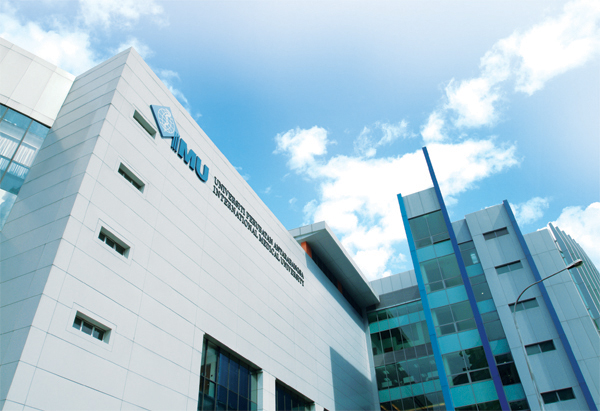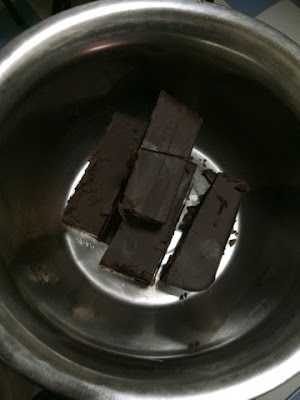First Hospital Visit
Assalamualaikum warahmatullahi wabarakatuh.
As I already promised, in this post I'm gonna tell you how was my hospital visit to Hospital Tuanku Jaafar Seremban and what I learned yesterday.
Before this yes, I did a work shadowing in KPJ when I was doing my A Level in INTI but the fact as we know, there are lots of differences between a govt and private hospital.
Besides, this time we had to shadow nurses instead of doctors!
I was really really really looked forward to this nursing week and it turned out that almost everything was awesome!
I slept early the night before so that I won't wake up late on the next day.
We gathered in front of IMU by 7 and as usual, Sanaa and I arrived sharp at 7 just few seconds right before the bus took off.
Usually I sleep straight away when the bus leaves but yesterday, I was not!
I was very excited that I felt like every single second was really precious and shouldn't be wasted by sleeping haha.
We arrived HTJ about 1 hour later.
The bus stopped quite far so we had to walk from there to the hospital (ceh mcm princess nak hantar sampai depan pintu).
We were supposed to gather in IMU clinical school Seremban which is located just opposite to the main hospital building, but unfortunately we overlooked the clinical school entrance and lost in the hospital haha.
Long story cut short a bit, we arrived and were divided into few groups.
My group mates were Nawal, Wooi Ye, Sinthia and Malani.
A sister was assigned to guide us throughout the whole day in the hospital.
Luckily all of my group mates understand Malay language so we don't have to translate what the sister said.
Our journey began at the accident and emergency (A&E) department.
There are 3 main rooms in the A&E; Red, Yellow and Green Zone.
Patients who come will have to undergo an initial observation (before going to a specific room) such as simple physical exam and vital signs which included body temperature, pulse rate, respiratory/breathing rate and blood pressure.
But usually, patients who are very critical will definitely being sent directly to the Red Room.
For asthma patients, they will be directed to a special small room which has nebuliser, oxygen etc.
We stopped in front of the Red Zone while the sister was telling us about how ambulance operates once they receive emergency call.
Then suddenly, a guy came out with a lady who cried uncontrollably.
The guy was trying to console the lady while walking together out from the Red Zone.
Past patted my shoulder and memories flashed into the back of my mind.
Adrenaline rushed passing through my veins.
Woosh.
The lady reminded me of myself few months ago when datuk passed away.
I know how she felt.
The feeling of losing someone you really love.
Gosh, I know I shouldn't think bout sad things at this time so I tried my best to forget bout it and get back into the right track.
Then the sister showed us mammography room, x-ray, all those kind of scans, forensic department (included the mortuary) and few other clinics and departments before going to wards.
The sister explained to us about the wards.
Men and women are separated in different rooms and there are few types of wards.
First one is surgical wards.
For ortho as for example, there are 2 surgical wards for male and that 2 wards are either active or passive.
Admitted patients will be placed in the active wards only.
While the passive ward has to discharge patients and get ready as it will become active (accept patients) on the next day.
Surgical wards are "alternate days" but not medical wards.
Medical wards are "alternate patients", and that means all medical wards are always active to receive patients.
Because the sister that guided us is belonged to the medical ward, so most of our time we spent in the ward, observing patients with different diseases, problems and concerns.
It is an ethical duty to keep patients information confidential.
So I would just roughly tell what we learned on that day without mentioning any names or diseases.
My group mates and I got the chance to know the procedures for Ryle's tube feeding, body washing, blood sugar level test, case clerking by both House Officer (HO) and Medical Officer (MO), oral feeding, report passing (between nurses), vital signs and arrangement & function of equipments.
The ward wasn't too noisy, I took some time to listen carefully to the surrounding sounds.
I could only hear a constant beep sound, nurses chit-chatted discussing about work, doctors talked to patients and some other soft voices among the patients themselves.
I have this one habit which I would keep quiet and observe my surrounding; not only people, but also sound, smell etc.
I tried as best as I could to capture everything and keep them in my mind.
Those were not the only things that fascinated me, but also stories from patients, their hardships and concerns regarding their health status really made me touched.
There was a patient who's very poor.
He told us that he already asked for the doctor's permission to go back home tomorrow.
The sister told the guy that he couldn't go back until he feels well but he kept insisting to go back and said that he really need to go home because his wife is sick.
And there was another old guy who was being interviewed by an HO (case clerking) told the doctor bout his condition and family background.
His daughter was standing beside his bed.
Previously he worked as a farmer but after he broke his leg etc, he couldn't work anymore.
And his wife is in Rumah Orang-Orang Tua.
Another story which broke my heart.
I know one day I have to face this.
It would be quite tough so I have to learn balancing my emotions and feelings between empathy, sadness etc.
Of course if you be the patient, you don't wanna see a doctor cries after listening to your story and concerns right?
This hospital visit was really worth it.
I appreciate every single second I had in the hospital.
Usually you only get the chance to view the hospital as a patient and that's another reason why I really really glad I had this hospital visit.
Looking forward to more hospital visits in the future.
To be honest, I can't wait to get a scroll and start my life as a houseman.
Can't wait to be busy going here and there, interviewing and taking care of patients' health!
InshaaAllah another few years -- Dr. Ardilla is ready to treat everyone.
Assalamualaikum :)
As I already promised, in this post I'm gonna tell you how was my hospital visit to Hospital Tuanku Jaafar Seremban and what I learned yesterday.
Before this yes, I did a work shadowing in KPJ when I was doing my A Level in INTI but the fact as we know, there are lots of differences between a govt and private hospital.
Besides, this time we had to shadow nurses instead of doctors!
I was really really really looked forward to this nursing week and it turned out that almost everything was awesome!
I slept early the night before so that I won't wake up late on the next day.
We gathered in front of IMU by 7 and as usual, Sanaa and I arrived sharp at 7 just few seconds right before the bus took off.
Usually I sleep straight away when the bus leaves but yesterday, I was not!
I was very excited that I felt like every single second was really precious and shouldn't be wasted by sleeping haha.
We arrived HTJ about 1 hour later.
The bus stopped quite far so we had to walk from there to the hospital (ceh mcm princess nak hantar sampai depan pintu).
We were supposed to gather in IMU clinical school Seremban which is located just opposite to the main hospital building, but unfortunately we overlooked the clinical school entrance and lost in the hospital haha.
Long story cut short a bit, we arrived and were divided into few groups.
My group mates were Nawal, Wooi Ye, Sinthia and Malani.
A sister was assigned to guide us throughout the whole day in the hospital.
Luckily all of my group mates understand Malay language so we don't have to translate what the sister said.
Our journey began at the accident and emergency (A&E) department.
There are 3 main rooms in the A&E; Red, Yellow and Green Zone.
Patients who come will have to undergo an initial observation (before going to a specific room) such as simple physical exam and vital signs which included body temperature, pulse rate, respiratory/breathing rate and blood pressure.
But usually, patients who are very critical will definitely being sent directly to the Red Room.
For asthma patients, they will be directed to a special small room which has nebuliser, oxygen etc.
We stopped in front of the Red Zone while the sister was telling us about how ambulance operates once they receive emergency call.
Then suddenly, a guy came out with a lady who cried uncontrollably.
The guy was trying to console the lady while walking together out from the Red Zone.
Past patted my shoulder and memories flashed into the back of my mind.
Adrenaline rushed passing through my veins.
Woosh.
The lady reminded me of myself few months ago when datuk passed away.
I know how she felt.
The feeling of losing someone you really love.
Gosh, I know I shouldn't think bout sad things at this time so I tried my best to forget bout it and get back into the right track.
Then the sister showed us mammography room, x-ray, all those kind of scans, forensic department (included the mortuary) and few other clinics and departments before going to wards.
The sister explained to us about the wards.
Men and women are separated in different rooms and there are few types of wards.
First one is surgical wards.
For ortho as for example, there are 2 surgical wards for male and that 2 wards are either active or passive.
Admitted patients will be placed in the active wards only.
While the passive ward has to discharge patients and get ready as it will become active (accept patients) on the next day.
Surgical wards are "alternate days" but not medical wards.
Medical wards are "alternate patients", and that means all medical wards are always active to receive patients.
Because the sister that guided us is belonged to the medical ward, so most of our time we spent in the ward, observing patients with different diseases, problems and concerns.
It is an ethical duty to keep patients information confidential.
So I would just roughly tell what we learned on that day without mentioning any names or diseases.
My group mates and I got the chance to know the procedures for Ryle's tube feeding, body washing, blood sugar level test, case clerking by both House Officer (HO) and Medical Officer (MO), oral feeding, report passing (between nurses), vital signs and arrangement & function of equipments.
The ward wasn't too noisy, I took some time to listen carefully to the surrounding sounds.
I could only hear a constant beep sound, nurses chit-chatted discussing about work, doctors talked to patients and some other soft voices among the patients themselves.
I have this one habit which I would keep quiet and observe my surrounding; not only people, but also sound, smell etc.
I tried as best as I could to capture everything and keep them in my mind.
Those were not the only things that fascinated me, but also stories from patients, their hardships and concerns regarding their health status really made me touched.
There was a patient who's very poor.
He told us that he already asked for the doctor's permission to go back home tomorrow.
The sister told the guy that he couldn't go back until he feels well but he kept insisting to go back and said that he really need to go home because his wife is sick.
And there was another old guy who was being interviewed by an HO (case clerking) told the doctor bout his condition and family background.
His daughter was standing beside his bed.
Previously he worked as a farmer but after he broke his leg etc, he couldn't work anymore.
And his wife is in Rumah Orang-Orang Tua.
Another story which broke my heart.
I know one day I have to face this.
It would be quite tough so I have to learn balancing my emotions and feelings between empathy, sadness etc.
Of course if you be the patient, you don't wanna see a doctor cries after listening to your story and concerns right?
This hospital visit was really worth it.
I appreciate every single second I had in the hospital.
Usually you only get the chance to view the hospital as a patient and that's another reason why I really really glad I had this hospital visit.
Looking forward to more hospital visits in the future.
To be honest, I can't wait to get a scroll and start my life as a houseman.
Can't wait to be busy going here and there, interviewing and taking care of patients' health!
InshaaAllah another few years -- Dr. Ardilla is ready to treat everyone.
Assalamualaikum :)






try going to the psychiatric ward ;)
ReplyDeleteI will request it later! :D
DeleteHi Dr Ardilla
ReplyDeleteHi Kak Umie!
DeleteHi do you have a link to your experience at KPj? I’ve Dm u via Instagram :)
ReplyDeleteHi. I don't think I posted anything about KPJ. Sorry :/
Delete